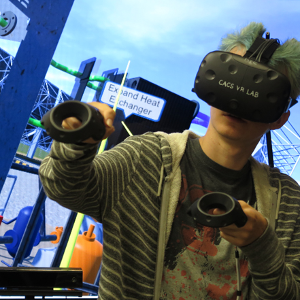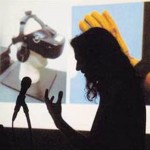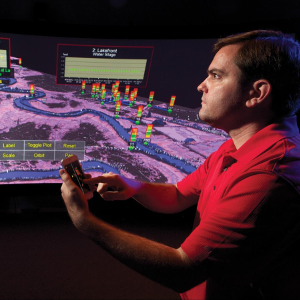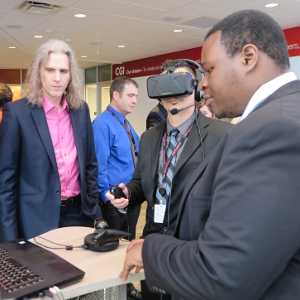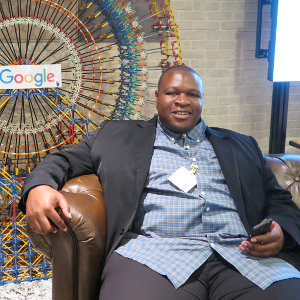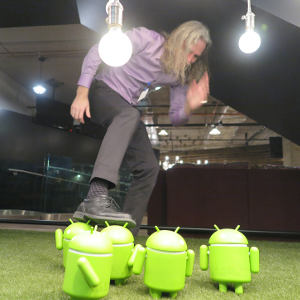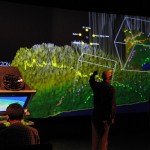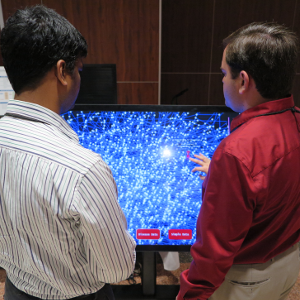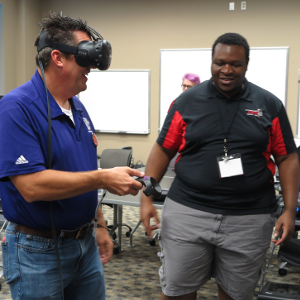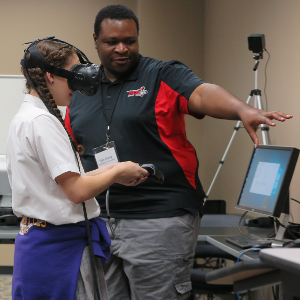Home
The CACS VR Lab was established by Christoph W. Borst in 2003. It provides students and researchers with graphics workstations, VR displays, touch displays, force feedback devices, and various 3D trackers and input devices.
Graduate assistantships are available in our current focus areas: 1) Eye tracked and networked VR with educational contexts and 2) Visual analytics for large datasets. Assistantships require a background in graphics (such as CMPS 415) or 3D game development (ideally Unity-based). These are Ph.D.-level positions, but strong Master-level students may be considered. Assistants must maintain a regular work schedule in the VR Lab, develop a project plan with ongoing documentation of progress, take relevant classes and research credits, and produce research results.
Undergraduate internships are available for work on educational VR games.
Students can also participate through special projects (490, 590) or advanced topics classes (499, 619). A VR course in Spring provides an introduction to VR with projects chosen by students.
Latest News
- Papers accepted in ISMAR 2024
- Oct 2019: Borst and Kulshreshth chair ACM SUI Symposium
- Sep 2019: Lab research featured in La Louisiane
- Apr 2019: New Equipment Grant for VR Research, Education, and Outreach
- Aug 2018: New NSF Grant for Eye-Tracked VR Research
- Aug 2018: Lab assistants featured in Gigavation video highlighting community impact
- Lab Shows Intercontinental Networked VR and Receives Grants from Mozilla and US Ignite
- VR Lab Wins Best Research Demo Award at the IEEE Virtual Reality 2017 Conference
- Borst Named State Winner of LACUE’s 2016 Post-Secondary Educator Award
- Educational VR Research Receives 2016 US Ignite Demo Award
- REU student Sam Ekong receives 2015 Excellence in Undergraduate Research award
Research Areas
- Networked VR, especially for educational or training environments
- 3DUI: Interaction Techniques for VR and visualization systems
- Haptics: Touch and Force Feedback
- Applications of VR and graphics
Lab Equipment
- PCs and laptops with high-end graphics
- VR and AR displays:
- Assorted headsets: Oculus, Vive, HoloLens, and older headsets
- Projection-based: 13-foot 3D projection display (Visbox-HD13) with motion tracker, and additional portable stereo projectors
- Other: Mirror-based “fishtank” displays, 3D LCDs, 3D TVs up to 75″
- Tracking: VR headsets with eye tracking, Vicon MX3+ motion capture systems, and older VR trackers: Intersense IS-900, Polhemus Fastrak, Ascension Minibird and Flock, Optitrack, PhaseSpace Impulse
- Gloves: 18 and 22 sensor Cybergloves, Cybergrasp, Rutgers Master II, 5DT, P5
- Styli: Phantom Premium 1.5 and Omni force-feedback devices
- Touch displays: Smartphones, 32″ and 55″ LCDs with 40 touch points
- Numerous HCI peripherals (e.g., Kinect, Razor Hydra, Myo armband, Empatica E4, Creative Senz3D, etc.)
- Access to large-scale projection via LITE
Courses
- Computer Graphics (Fall semesters)
- Virtual Reality (Spring semesters)
- Special topics courses (vary by year): Virtual Reality Experiments, 3D Interaction
- Advanced Topics (CSCE 619, 598, 590, CMPS 499)

